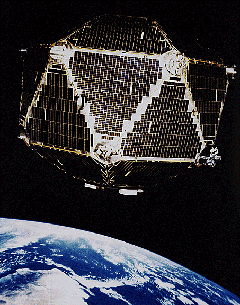Vela 5b: The Vela satellites provided much information useful to astronomers studying gamma radiation from space. Other Vela satellites operated for approximately one year, but Vela 5b was in service for more a decade, from 1969 to 1979.
Credit: NASA
My first love was gamma-ray bursts (GRBs)--the tremendous explosions that rock the Universe like nothing else. They happen when super massive stars use up all their fuel and collapse or when compact stars collide and merge. I first started working on gamma-ray bursts in 1978, when I was doing my Ph.D. work. I used to joke that there were 2 1/2 or 3 1/2 GRB astronomers at the time, and I was the half. I was just very intrigued by these bursts. They were a brand-new phenomenon and we didn't know anything about them. There were maybe three or four instruments at the time capable of even seeing them.
Remember, GRBs were only discovered in 1967, when the Vela satellites were launched. They observed the first gamma-ray burst in 1967, and then many more, but all scientists could say is that GRBs didn't come from the solar system. There was so much mystery surrounding the bursts that the first paper on the discovery of GRBs didn’t even come out until 1973--when I was still in high school.
I did my Ph.D. thesis on GRBs in 1981. I was probably the first person ever to earn a Ph.D .with a thesis on these explosions! Then I taught Physics and Astronomy at the University of Athens back in Greece for several years, but knew all the while I really wanted to do research. So I spent every vacation and my one-year sabbatical in the United States doing research at NASA.


